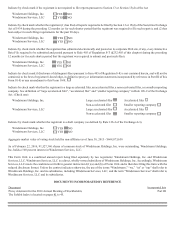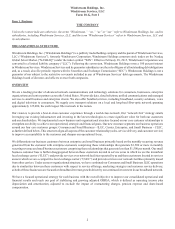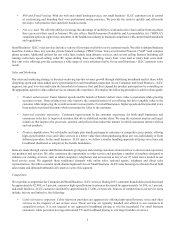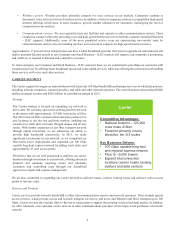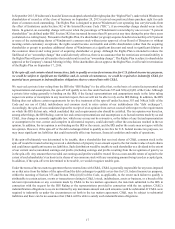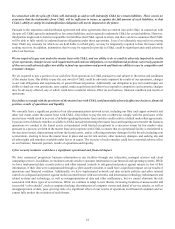Windstream 2015 Annual Report Download - page 91
Download and view the complete annual report
Please find page 91 of the 2015 Windstream annual report below. You can navigate through the pages in the report by either clicking on the pages listed below, or by using the keyword search tool below to find specific information within the annual report.
9
SMALL BUSINESS - CLEC SEGMENT
Our Small Business CLEC segment consists of small business
customers residing outside of our ILEC footprint. During 2015,
this segment generated revenue of $559 million and contribution
margin of $181 million.
Our Small Business - CLEC strategy is focused on retaining our
most profitable customers, selling incremental services and
locations to existing customers, targeting new sales in select
markets, and managing customer-level profit margins to
moderate revenue and contribution margin declines and
maximize profitability. Operational efficiency and a highly
disciplined sales and support model are cornerstones of our
Small Business - CLEC strategy that should enable us to
maximize cash flows generated from this business.
Products and services provided to our Small Business - CLEC
customers include integrated voice and data services, advanced
data and traditional voice and long distance services. We also
offer on-line back-up, remote IT, managed web design, web
hosting and various email services to small business customers
in our CLEC footprint.
Similar to our Small Business - ILEC operations, we experience competition from cable television companies and other
communications carriers in areas served by our Small Business - CLEC segment.
REGULATORY AND OTHER REVENUES
Regulatory and certain other operating revenues are derived from activities that are centrally-managed by us and, accordingly,
these revenues are not included in any of our four segments presented above. Regulatory revenues include switched access revenues,
federal and state Universal Service Fund (“USF”) revenues, Connect America Fund (“CAF”) support and funds received from the
access recovery mechanism (“ARM”). Switched access revenues include usage sensitive revenues from long-distance companies
and other local exchange carriers for access to our network in connection with the completion of long-distance calls, as well as
reciprocal compensation received from wireless and other local connecting carriers for the use of our network facilities. We also
receive compensation from wireless and other local exchange carriers for the use of our facilities.
USF revenues are government subsidies designed to partially offset the cost of providing wireline services in high-cost areas. CAF
Phase II funding is administered by the Federal Communications Commission (“FCC”) for the purpose of expanding and supporting
broadband service in rural areas and effectively replaces frozen USF support in those states in which we elected to receive the
CAF Phase II funding, as further described below. The ARM is additional federal universal service support available to help
mitigate revenue losses from intercarrier compensation reform not covered by the access recovery charge (“ARC”), a monthly
charge assessed to customers established by the FCC.
On August 5, 2015, we notified the FCC of our acceptance of CAF Phase II support of approximately $175.0 million per year for
a six year period to fund the deployment of voice and high-speed Internet capable infrastructures for approximately 400,000 eligible
locations in 17 of the 18 states in which we are the incumbent provider, declining only the annual statewide funding in New Mexico
because our projected cost to comply with the FCC’s deployment requirements greatly exceeded the funding offer. The CAF Phase
II support for the 17 states we accepted substantially replaces funding we received under the federal USF high-cost support program.
We will be eligible to participate in a competitive bidding process for the CAF Phase II support in New Mexico, along with other
interested eligible competitors under an auction process administered by the FCC, which is expected to be held during 2016. We
will continue to receive annual USF support in New Mexico frozen at 2011 levels until the CAF Phase II competitive bidding
process is completed.
Other operating revenues primarily consist of USF surcharges and other costs passed through to our customers, sales of
communications equipment to third party contractors and revenues from other miscellaneous service offerings.
Small Business - CLEC
Competitive Advantage:
• Ability to leverage
Enterprise infrastructure
Key Business Driver:
• Improve profitability by
focusing on growing
profitable customer
relationships and managing
costs



